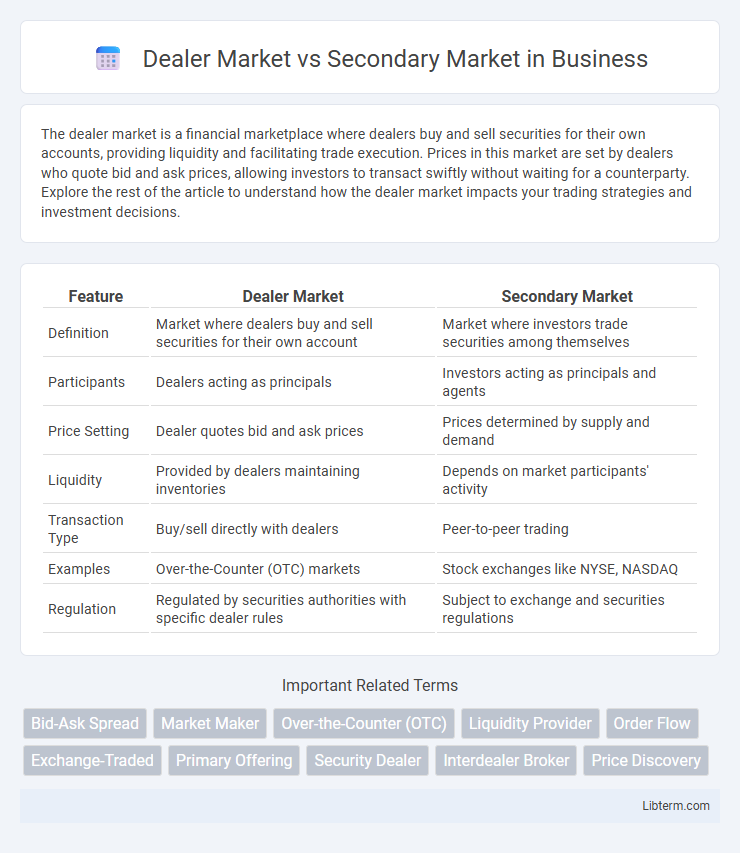The dealer market is a financial marketplace where dealers buy and sell securities for their own accounts, providing liquidity and facilitating trade execution. Prices in this market are set by dealers who quote bid and ask prices, allowing investors to transact swiftly without waiting for a counterparty. Explore the rest of the article to understand how the dealer market impacts your trading strategies and investment decisions.
Table of Comparison
| Feature | Dealer Market | Secondary Market |
|---|---|---|
| Definition | Market where dealers buy and sell securities for their own account | Market where investors trade securities among themselves |
| Participants | Dealers acting as principals | Investors acting as principals and agents |
| Price Setting | Dealer quotes bid and ask prices | Prices determined by supply and demand |
| Liquidity | Provided by dealers maintaining inventories | Depends on market participants' activity |
| Transaction Type | Buy/sell directly with dealers | Peer-to-peer trading |
| Examples | Over-the-Counter (OTC) markets | Stock exchanges like NYSE, NASDAQ |
| Regulation | Regulated by securities authorities with specific dealer rules | Subject to exchange and securities regulations |
Introduction to Dealer Market and Secondary Market
The dealer market operates through a network of dealers who buy and sell securities for their own accounts, providing liquidity and continuous pricing, unlike the secondary market where investors trade securities among themselves after the initial offering. In the dealer market, transactions occur over-the-counter (OTC) with dealers maintaining inventories of stocks or bonds to facilitate trading. The secondary market encompasses both dealer markets and auction markets, enabling price discovery and efficient capital allocation by allowing the buying and selling of previously issued securities.
Key Definitions: Dealer Market vs Secondary Market
A dealer market is a financial market where multiple dealers post prices at which they will buy and sell securities, acting as principals and holding inventory to facilitate trading. In contrast, a secondary market is a broad category of markets where previously issued securities are traded between investors, encompassing various types including dealer markets, auction markets, and electronic exchanges. Key distinctions lie in dealer markets' reliance on dealers for liquidity provision, while the secondary market refers to the overall environment where securities are exchanged after initial issuance.
How Dealer Markets Operate
Dealer markets operate through a network of dealers who maintain inventories of securities, buying and selling directly to investors at prices they set. These dealers provide liquidity by quoting bid and ask prices, profiting from the spread between them, and facilitating continuous trading without the need for a centralized exchange. This decentralized system contrasts with auction-style secondary markets where buyers and sellers transact orders through a centralized order book.
How Secondary Markets Operate
Secondary markets operate by facilitating the trading of financial securities such as stocks and bonds between investors after the initial issuance. Transactions occur through organized exchanges like the New York Stock Exchange or over-the-counter (OTC) platforms, where prices are determined by supply and demand dynamics. Market makers and brokers play critical roles in ensuring liquidity and efficient price discovery in these markets.
Major Differences Between Dealer Market and Secondary Market
Dealer markets involve transactions facilitated by market makers who actively buy and sell securities from their own inventories, providing liquidity and setting bid-ask prices. Secondary markets refer broadly to platforms where investors trade existing securities, including both dealer markets and auction markets like stock exchanges. The major difference lies in the dealer market's reliance on dealers' inventories and price quotations, whereas secondary markets encompass all trading of previously issued securities, including direct trades between investors without intermediary dealers.
Pros and Cons of Dealer Markets
Dealer markets offer enhanced liquidity by allowing continuous bid and ask prices from multiple dealers, facilitating faster transaction execution and tighter spreads. However, they often involve higher transaction costs and potential conflicts of interest since dealers act as principals, which can impact price transparency. Despite these drawbacks, dealer markets provide significant benefits for trading less liquid securities or large, complex transactions.
Pros and Cons of Secondary Markets
Secondary markets provide liquidity, enabling investors to quickly buy and sell securities, which helps in price discovery and reflects real-time market values. However, the reliance on market sentiment can lead to price volatility and potential mispricing compared to dealer markets where transactions occur over-the-counter with negotiated prices. The accessibility of secondary markets encourages broader participation but exposes investors to risks related to market fluctuations and less control over trade execution.
Types of Instruments Traded in Each Market
Dealer markets primarily facilitate trading in over-the-counter (OTC) instruments such as bonds, derivatives, and foreign exchange, where dealers hold inventories and provide liquidity. Secondary markets focus on standardized instruments like stocks and exchange-traded funds (ETFs), enabling investors to buy and sell securities through organized exchanges or electronic platforms. The diversity in traded instruments reflects the dealer market's emphasis on customized, less liquid assets versus the secondary market's role in transferring ownership of publicly listed securities.
Impact on Liquidity and Pricing
The dealer market enhances liquidity by enabling continuous buying and selling through dealer inventories, which facilitates smoother price discovery and tighter bid-ask spreads. In contrast, the secondary market relies on direct transactions between investors, often resulting in less immediate liquidity and wider price fluctuations. Consequently, dealer markets generally provide more consistent pricing and quicker execution, benefiting both buyers and sellers.
Choosing Between Dealer Market and Secondary Market
Choosing between a dealer market and a secondary market depends on liquidity needs and transaction transparency; dealer markets offer continuous price quoting by dealers, enhancing immediate trade execution but potentially increasing spreads. Secondary markets provide greater price transparency through centralized exchanges, benefiting investors seeking standardized and regulated trading environments. Evaluating factors like transaction costs, market depth, and risk tolerance helps determine the optimal choice for trading equities or fixed-income securities.
Dealer Market Infographic

 libterm.com
libterm.com